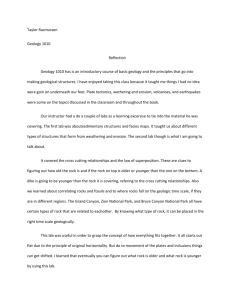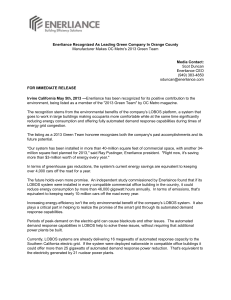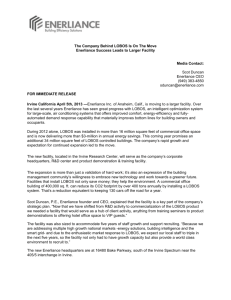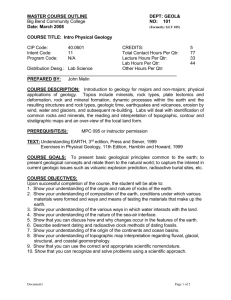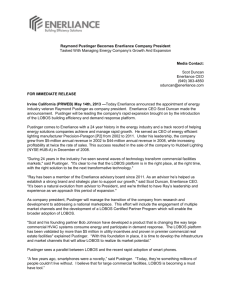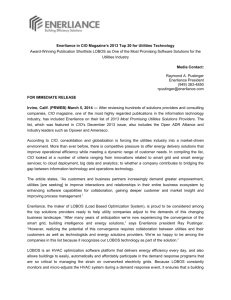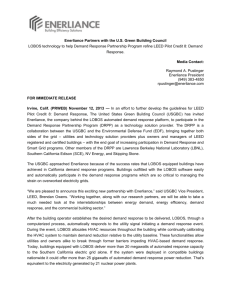Geology 2 – Physical Geology Lab
advertisement
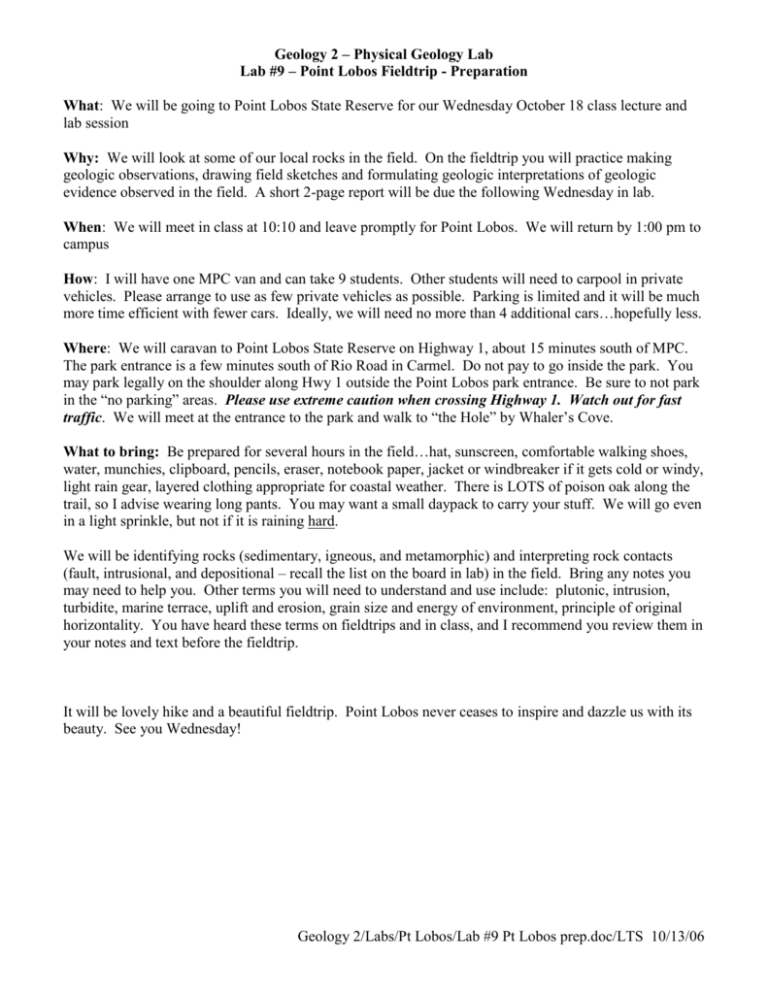
Geology 2 – Physical Geology Lab Lab #9 – Point Lobos Fieldtrip - Preparation What: We will be going to Point Lobos State Reserve for our Wednesday October 18 class lecture and lab session Why: We will look at some of our local rocks in the field. On the fieldtrip you will practice making geologic observations, drawing field sketches and formulating geologic interpretations of geologic evidence observed in the field. A short 2-page report will be due the following Wednesday in lab. When: We will meet in class at 10:10 and leave promptly for Point Lobos. We will return by 1:00 pm to campus How: I will have one MPC van and can take 9 students. Other students will need to carpool in private vehicles. Please arrange to use as few private vehicles as possible. Parking is limited and it will be much more time efficient with fewer cars. Ideally, we will need no more than 4 additional cars…hopefully less. Where: We will caravan to Point Lobos State Reserve on Highway 1, about 15 minutes south of MPC. The park entrance is a few minutes south of Rio Road in Carmel. Do not pay to go inside the park. You may park legally on the shoulder along Hwy 1 outside the Point Lobos park entrance. Be sure to not park in the “no parking” areas. Please use extreme caution when crossing Highway 1. Watch out for fast traffic. We will meet at the entrance to the park and walk to “the Hole” by Whaler’s Cove. What to bring: Be prepared for several hours in the field…hat, sunscreen, comfortable walking shoes, water, munchies, clipboard, pencils, eraser, notebook paper, jacket or windbreaker if it gets cold or windy, light rain gear, layered clothing appropriate for coastal weather. There is LOTS of poison oak along the trail, so I advise wearing long pants. You may want a small daypack to carry your stuff. We will go even in a light sprinkle, but not if it is raining hard. We will be identifying rocks (sedimentary, igneous, and metamorphic) and interpreting rock contacts (fault, intrusional, and depositional – recall the list on the board in lab) in the field. Bring any notes you may need to help you. Other terms you will need to understand and use include: plutonic, intrusion, turbidite, marine terrace, uplift and erosion, grain size and energy of environment, principle of original horizontality. You have heard these terms on fieldtrips and in class, and I recommend you review them in your notes and text before the fieldtrip. It will be lovely hike and a beautiful fieldtrip. Point Lobos never ceases to inspire and dazzle us with its beauty. See you Wednesday! Geology 2/Labs/Pt Lobos/Lab #9 Pt Lobos prep.doc/LTS 10/13/06 Geology 2 – Physical Geology Lab Lab #9 – Point Lobos Fieldtrip MPC Geology 2 Lab #9 – Point Lobos Learning Outcomes: Experience making geologic observations of rocks at the outcrop scale Experience writing scientific field notes. Experience sketching a stratigraphic column to record your observations and labeling important aspects of the sketch for communication purposes. Experience interpreting the origin of sedimentary rock by analyzing grain composition, size, and shape. Experience interpreting the origin of igneous rock by analyzing grain composition, size, and shape. Experience analyzing the relationship between rock types by looking at the contact between them. Experience interpreting the basic geologic history of the area by combining the origin of observed rock types and analyses of the contacts between them. Experience writing a short scientific field report detailing the results of your investigation. Logistics: Part I – We will spend 3 hours at Point Lobos State Reserve examining several rock outcrops. You will be taking field notes of your observations and creating stratigraphic columns that document your field observations. Part II – A short written field report in the format specified in this lab that clearly conveys your observations and your interpretations of the geologic history of the outcrops we study. The report is due at 11:10 AM at next week’s lab. Part 1: Field Survey at Point Lobos We will look at several outcrops at Point Lobos where we will describe the rocks in detail and sketch them, as they appear in the outcrop in a “stratigraphic column”. We will examine an outcrop together as a class. I will demonstrate how to take field notes and sketch a stratigraphic column of the outcrop. Then, you will have an opportunity to examine in detail two outcrops on your own. Procedure: 1) Field notes introduction: Your field notes should begin with 1) date, 2) location, 3) weather description, 4) purpose, and 5) others in work team. 2 MPC Geology 2 Lab #9 – Point Lobos 2) Description of rock outcrop: To help you in your observations and later in your interpretations, consider the following questions. Make detailed and complete notes for each of these characteristics. a) To b) To describe sedimentary rocks, look closely at… Composition of matrix or cement Color of the matrix Describe the particles or clasts by their, size (average, largest, smallest), sorting, and rounding composition Thickness of the bed or layer. Presence of fossils Estimate of dip or angle of bed in relationship to horizontal and if dipping, in which direction Any prominent features Type of sedimentary rock describe igneous rocks, look closely at… Grain size Composition Color Thickness of unit Any prominent features Type of igneous rock c) Describe any contacts between different layers or rock types Is there any evidence of faulting or shearing? of contact metamorphism? of intrusions? of Inclusions? Is there any evidence of cross cutting relationships (i.e., do any veins, beds, or layers within either of the rock types appear to be cut off by the other rock type)? Is the contact conformable or nonconformable? If nonconformable, what type? 3) Sketch: Draw a sketch of the outcrop to create a stratigraphic column. Use parallel vertical lines to define the sides of the outcrop that you sketch. Include details of what you see in the rocks. Be sure to draw the layers to scale with proportional layer thickness. Indicate approximate thickness of each layer. Draw in the correct rock type symbols that we used in lab. Label each layer with its rock name. Label each contact with the type of contact. Identify any significant features with arrows and labels. 3 MPC Geology 2 Lab #9 – Point Lobos 4) Interpretation. After examining the rock outcrop, use your collected field data to formulate a hypothesis about how the rocks were formed or their depositional environment. What do the clast size, sorting, and rounding suggest about the energy of the depositional setting? What does the composition of the clasts tell about its source? What does the grain size and composition suggest about its formation? What does the contact(s) suggest happened to the rocks here? Part II: Field Report Use the following guidelines for achieving an exemplary field report. Imagine you are writing a brief geologic field report to inform someone about a geologic history you have interpreted from the rock record. Your target audience is a “client” or “employer” who has a working knowledge of science and its principles, but has a weak understanding of geology, (which is why you were hired!). Use perfect English, including excellent grammar and paragraph structure. Be sure to focus on providing data to support any interpretations. The information you provide should include text, field sketches, and maps to communicate the key points. Every report should have a location map of where the information was collected. Your report should be no more than four pages long, not including your field notes. Your report should have the following sections: 1) Title: Short & informative 2) Introduction: Very briefly introduce topic of data collection, including date, type of data collected, and final product. Be sure to include purpose of the report. Provide place names and small, rough location map. The location map may be neatly hand-drawn. 3) Data: Your observations communicated in a combination of prose, outcrop descriptions, field sketch, and stratigraphic columns. These data will be recorded in your field notes. For each stratigraphic column write one paragraph that explains the important observations you made and include them on your sketch. Write your paragraph with the idea that you are making sure the reader does not miss anything important on the stratigraphic column. Include arrows and labels that point out the important features on your stratigraphic columns. Your sketches should be neat and well labeled. Each stratigraphic column should include a one or two sentence caption that explains to the reader what it is. This section should be no more than 2 pages. 4) Interpretations: Provide a summary of the interpretations or conclusions you drew, with direct reference to the data you provided in the “data” section. Avoid over interpreting…..stick to the “facts.” Describe a simple geologic history of the outcrops 4 MPC Geology 2 Lab #9 – Point Lobos you studied, based upon the rocks and contacts you recorded in your notes. You may include the geologic history in outline form, with the youngest events at the top to the oldest events at the bottom. 5) Field Notes: Attach your field notes and field sketches to the back of the report. They should not be rewritten. Your field notes do not count toward the 4 page limit on the report. CAUTION!! AVOID WRITING A NARRATIVE STORY In scientific writing, a client does not care what you did during your day of fieldwork, and so avoid the first person narrative voice, such as…”On Friday the 13th of December I went to the beach to look at sand dune shapes. I walked to the beach over a very steep dune and I saw several smaller dunes.” Compare the following prose that is not in the “first person.” “A study of sand dune shapes indicates that dunes are steep on the side facing away from the prevailing winds. Sand dunes locally occur in a wide array of sizes, from approximately 4 m tall to 23 m tall.” Avoid reference to Geo 2 or your “class.” Instead, focus on the observations and interpretations. Due Date and Assessment Report is due at the beginning of lab on the week following the field experience. Reports will not be accepted after the first 5 minutes of the class when they are due. The report will be assessed on accuracy of content, correct format as specified in the lab, correct English grammar, and timely completion. Learning Experience Writing about experiential learning serves several functions. It is a sound way of assessing your learning. It is a way to solidify your knowledge base by enforcing a review of the fieldtrip. Writing also provides the opportunity for you to evaluate your field note skills. Complete, legible, reproducible field notes will foster good report writing. The need for good note taking skills fosters good observational and listening skills. Most importantly, this exercise will give you experience and practice that you will need to do a good job for the final lab project. http://www.gvsu.edu/index.cfm?fuseaction=home.maps Geology 2/Labs/Pt Lobos/Lab #9 Pt Lobos.doc/LTS 10/16/06 5



